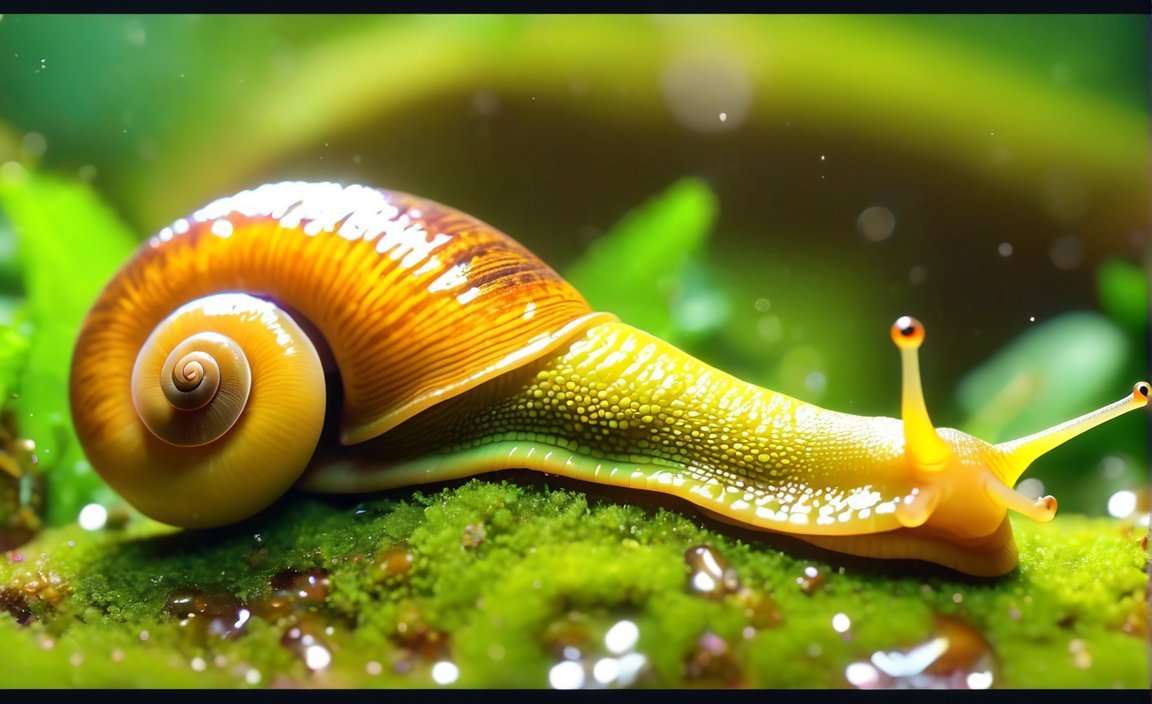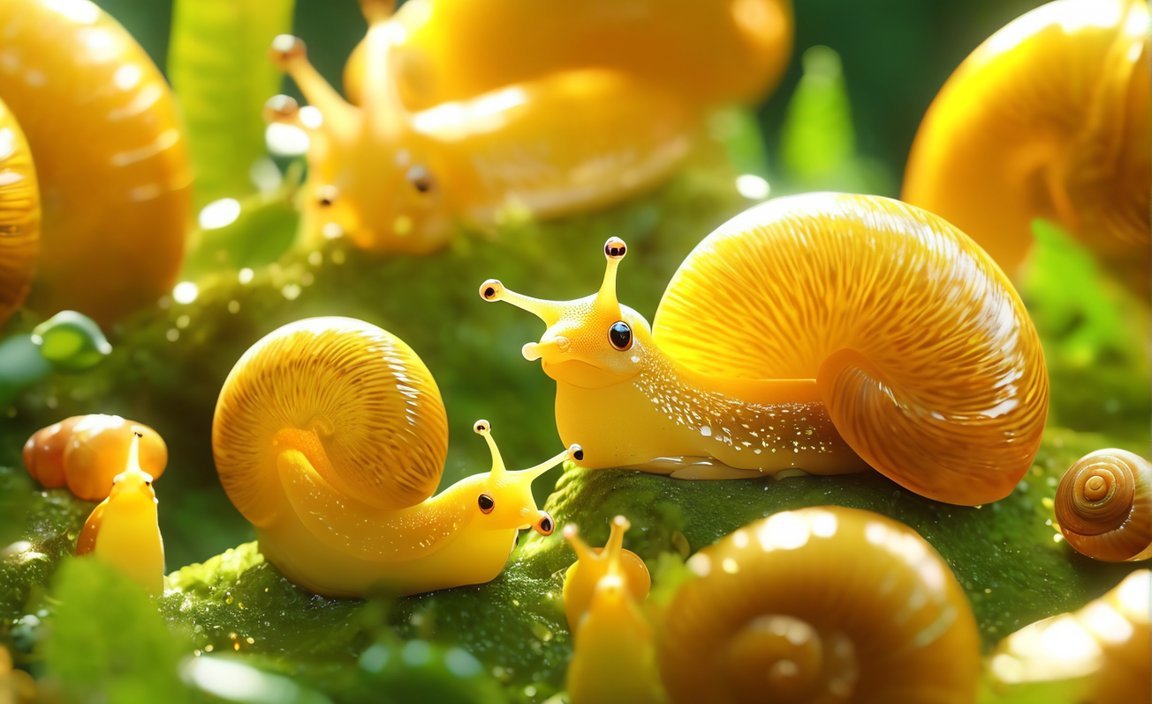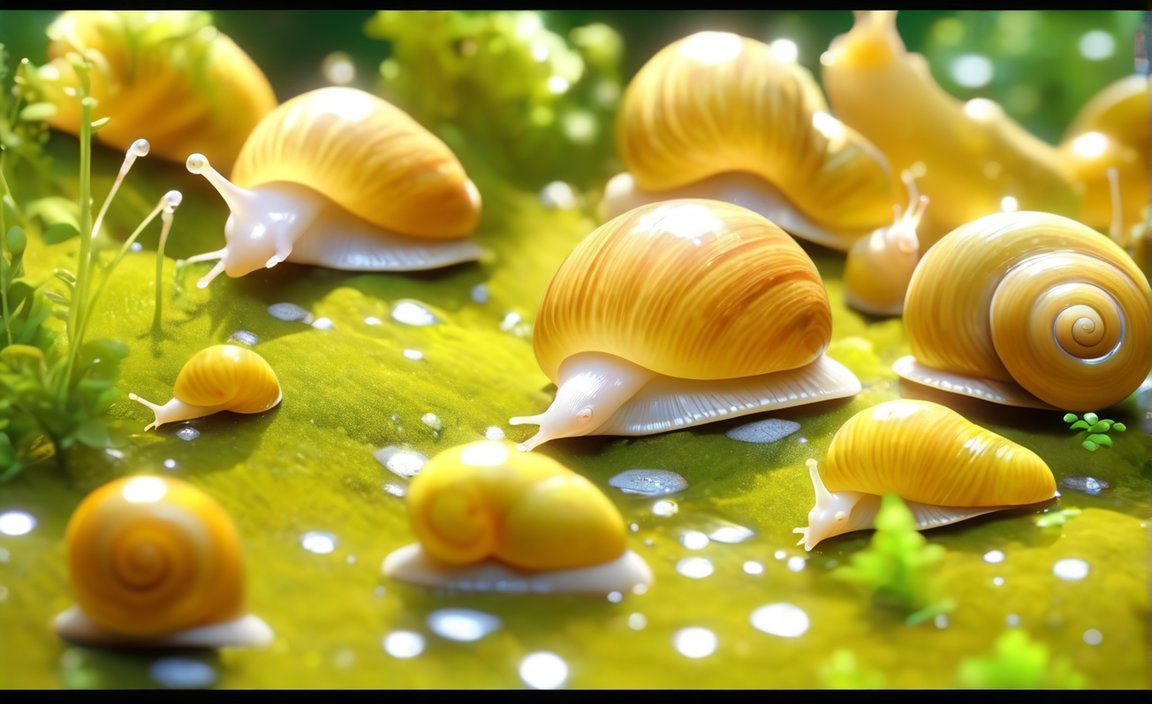Get ready to be amazed by the incredible world of slugs and snails as we uncover ten fascinating facts about these intriguing creatures. From their unique adaptations to their vital ecological roles, prepare to be captivated by the remarkable characteristics of slugs and snails. Dive into the hidden wonders of these slimy creatures and embark on a journey of discovery as we unveil unexpected curiosities about their lives. Discover 10 Fascinating Facts About Slugs and Snails that will leave you with a newfound appreciation for the intricate beauty of the natural world.

Key Takeaways:
1. Snails have a coiled body and shell, while slugs have straight bodies and no shell. Both have tentacles with eyes on the tips.
2. Snails rely on their sense of smell since they cannot hear, using it to find food.
3. Snails leave slime behind as they travel, which helps to protect them as they move.
4. Snails can make their shells bigger as they grow, providing protection from heat and enemies.
5. Most snail species are hermaphrodites, meaning they have both female and male reproductive organs.
6. Snails are slow-moving creatures, with speeds ranging from 0.5 to 0.8 inches per second.
7. Predators of terrestrial snails include rats, beetles, turtles, mice, birds, and salamanders.
8. Snails have the most teeth of any animal, sleep for up to 3 years, and the fastest snail can move at a speed of 2.5 cm per second.
9. Slugs generate mucus to survive since their bodies are around 80-90% water. They can move at a top speed of 0.18 miles per hour and have four multi-functional tentacles.
To learn more about snails and slugs, refer to the following sources:
– Kids Britannica – Snail and Slug
– LoveToKnow – Snail Facts for Kids
10 Facts About Slugs and Snails
Snails and slugs may not be the fastest creatures on Earth, but they are definitely some of the most fascinating. These slimy creatures have some remarkable adaptations and unexpected curiosities. Here are ten intriguing facts about slugs and snails:
1. Physical Characteristics
Snails have a coiled body and shell, while slugs have straight bodies and no shell. Both snails and slugs have two long tentacles sticking out from the head, each with an eye at the tip[^1^].
2. Sense of Smell
Snails cannot hear, so they rely on their sense of smell to find food[^1^]. Their sense of smell is so powerful that they can detect certain odors even when they are miles away.
3. Protective Slime
Ever wondered why snails and slugs are so slimy? It turns out that the slime they leave behind as they travel helps protect them. The slime acts as a lubricant, allowing them to glide smoothly while also deterring predators[^1^].
4. Shell Growth
Snails have the amazing ability to make their shells bigger as they grow. Their shells provide protection from heat and enemies, making them essential for their survival[^1^].
5. Hermaphroditic Reproduction
Most snail species are hermaphrodites, meaning they have both female and male reproductive organs[^2^]. This unique characteristic enables them to mate with any other snail they encounter.
6. Speed
Snails are known for their slow pace, and for good reason! Their speed ranges between 0.5 and 0.8 inches per second, which makes them one of the slowest creatures on Earth[^1^]. It might take them a while to get from one place to another, but they certainly enjoy the journey.
7. Predators
Snails and slugs have many predators in the wild. Some of their main predators include rats, beetles, turtles, mice, birds, and salamanders[^1^]. These animals see snails and slugs as a tasty snack and play an important role in controlling their populations.
8. Additional Snail Facts
Snails have some astonishing facts that might surprise you. Did you know that snails have the most teeth of any animal? Their teeth are no bigger than the size of a pin[^4^]. Also, snails have the ability to sleep for up to three years[^4^]. Talk about beauty sleep!
9. Additional Slug Facts
Slugs, like snails, have some incredible characteristics. They generate mucus to survive, as their bodies are around 80-90% water[^5^]. This mucus helps keep them hydrated and protected. Additionally, slugs can move at a top speed of 0.18 miles per hour[^5^]. While it may not seem fast to us, it’s quite an accomplishment for these slow-moving creatures.
10. Conclusion
From their fascinating physical characteristics to their hermaphroditic reproduction and sleep patterns, slugs and snails are truly unique creatures. Their slow pace doesn’t stop them from thriving in their environments and playing important roles in various ecosystems. The next time you spot a snail or slug, take a moment to appreciate their remarkable adaptations and the intriguing world they represent.
To learn more about slugs and snails, you can visit the following sources:
These sources provide additional information on the topic and can be used as references for further research.
References:
[^1^]: Snail and Slug – Kids | Britannica Kids | Homework Help. (n.d.). Kids.britannica.com. Retrieved from source
[^2^]: Snail Facts for Kids. (n.d.). LoveToKnow. Retrieved from source
[^4^]: 50 Cool Snail Facts That You Didn’t Know Until Now. (n.d.). Facts.net. Retrieved from source
[^5^]: 10 Incredible Slug Facts. (n.d.). A-Z Animals. Retrieved from source
Here are some interesting facts to expand your knowledge:
10 facts about dogs in Hindi: Did you know that dogs have been serving humans for over 30,000 years? Discover more fascinating facts about these loyal companions in Hindi.
10 facts about ground pollution: Ground pollution is a pressing issue affecting our environment. Uncover surprising facts about the causes and consequences of ground pollution that you may not be aware of.
10 facts about marine animals: Dive into the deep blue and explore the incredible world of marine animals. From majestic sharks to colorful coral reefs, discover fascinating facts about these enchanting creatures.
10 facts about marine mammals: Have you ever wondered how marine mammals adapt to life in the ocean? Learn captivating facts about these intelligent and charismatic creatures, from playful dolphins to massive whales.
10 facts about ocean animals: Plunge into an exciting adventure beneath the waves and uncover extraordinary facts about ocean animals. From mysterious octopuses to magnificent sea turtles, the ocean holds endless wonders.
10 facts about pets: Pets bring joy, love, and companionship into our lives. Explore intriguing facts about various types of pets, from cuddly cats to loyal dogs, and discover the many benefits they offer.
10 facts about sea animals: Embark on a voyage to the depths of the sea and unravel captivating facts about the mesmerizing world of sea animals. From vibrant fish to graceful seahorses, get ready to be amazed.
10 facts about snapping turtles: Snapping turtles may seem fierce, but they have some truly fascinating traits. Discover intriguing facts about these ancient reptiles, known for their unique appearance and formidable jaws.
Expand your knowledge and satisfy your curiosity by clicking on these links to delve deeper into the captivating world of animals and the environment!
Some Species of Slugs and Snails: Unique Reproductive Abilities
From their slimy trails to their intricate shells, slugs and snails have always captivated nature enthusiasts. But did you know that some species of these remarkable mollusks possess a truly fascinating reproductive ability? Some species of slugs and snails are hermaphrodites, meaning they possess both male and female reproductive organs. Let’s dive into the intriguing world of gastropod reproduction and uncover ten captivating facts about these extraordinary creatures.
1. Varying Reproductive Systems
The reproductive system of slugs and snails varies significantly across different groups and species. While marine gastropods mostly have separate sexes, land snails are predominantly hermaphrodites. This diversity in reproductive systems adds to their overall complexity and uniqueness in the animal kingdom.
2. Alternating Roles in Marine Gastropods
In many marine gastropods, the genders alternate within a continuous cycle. They may start as females, transforming into males later in life, or vice versa. This phenomenon, known as protandrous sequential hermaphroditism, showcases the incredible adaptability and complexity of gastropod reproduction.
3. Simultaneous Hermaphrodites: Opisthobranchia
A subgroup of gastropods called Opisthobranchia takes hermaphroditism to another level. These sea-dwelling creatures possess both male and female reproductive organs simultaneously. This intriguing feature grants them the ability to engage in reciprocal mating, ensuring greater reproductive success.
4. Snail Diversity: Separate Sexes and Protandry
While most land snails are hermaphrodites, sea-dwelling prosobranch snails demonstrate separate sexes. Phylogenetic evidence further supports protandrous hermaphroditism in land gastropods, a fascinating reproductive strategy where individuals start as males and later develop into females.
5. Pulmonate Land Gastropods: Simultaneous Hermaphrodites
The majority of land snails, belonging to the group Pulmonata, are simultaneous hermaphrodites. This means they possess both male and female reproductive organs simultaneously. Their internal reproductive systems are complex, allowing for various modes of fertilization and reproduction.
6. Stylommatophorans: A Reproductive Vagary
Stylommatophorans, a diverse group of land snails, exhibit significant variability in their reproductive systems. Some species possess male copulatory organs, while others lack them altogether. This intriguing variation adds another layer of complexity to the reproductive world of slugs and snails.
7. Examples of Reproductive Systems
Two intriguing examples exemplify the diversity of snail reproductive systems. Anostoma depressum, a land snail, demonstrates simultaneous hermaphroditism, mirroring the capabilities of other pulmonate land gastropods. On the other hand, Helix pomatia, known as the Roman snail, follows a more traditional pattern of separate sexes.
Key Takeaways:
- Some species of slugs and snails are hermaphrodites, possessing both male and female reproductive organs.
- Marine gastropods showcase alternating male and female roles in a continuous cycle.
- Opisthobranchia gastropods are simultaneous hermaphrodites, having both reproductive organs at the same time.
- Land snails predominantly exhibit hermaphroditism, while sea-dwelling snails often have separate sexes.
- Pulmonate land gastropods are simultaneous hermaphrodites, possessing a complex internal reproductive system.
- Reproductive systems in stylommatophorans, like land snails, can vary significantly.
- Anostoma depressum and Helix pomatia are examples of land snails with different reproductive systems.
Sources:
– Wikipedia: Reproductive system of gastropods
– Wikipedia: Reproductive system of mollusks
The Slime: An Essential Secretion for Slugs and Snails
Throughout the intricate world of flora and fauna, few creatures spark curiosity quite like slugs and snails. These fascinating gastropods have captivated nature enthusiasts for generations. One of the most intriguing aspects of their existence lies in the slimy trail they leave behind as they glide gracefully through their environment. Indeed, the slime produced by slugs and snails serves multiple purposes, including locomotion, protection from predators, and moisture retention. Let’s delve deeper into the wonders of this slimy secretion.
The Multifaceted Nature of Slime
At first glance, the slimy trail left behind by slugs and snails may seem like nothing more than a slippery residue. However, upon closer inspection, it becomes evident that this seemingly humble secretion plays a crucial role in their survival.
Locomotion: The slime acts as a lubricant, allowing these gastropods to effortlessly glide across various surfaces. It reduces friction between their bodies and the ground, enabling smooth movement. Whether it’s crawling up a tree trunk or slithering across a damp grassy field, their slime provides the necessary slipperiness to navigate their surroundings with ease.
Protection: Slugs and snails rely on their slime as a protective shield. This sticky substance creates a slippery barrier that discourages predators from pursuing them. When potential threats, such as beetles or birds, attempt to grab hold of them, their slime makes it incredibly difficult for these assailants to maintain a solid grip. In essence, their slime acts as a self-defense mechanism, providing an extra layer of protection against the dangers of the natural world.
Moisture Retention: As delicate creatures, slugs and snails are highly susceptible to dehydration. However, their slime aids in retaining essential moisture. By leaving behind a trail of mucus, they create a moist environment that helps prevent their bodies from drying out. This ability to preserve moisture is particularly crucial for terrestrial gastropods, as they navigate through various habitats that may not offer an abundance of water sources.
The Science behind Slime
To truly appreciate the complexity of the slime produced by slugs and snails, we must explore its composition and the intricacies of its secretion.
Water Content: The slime secreted by these gastropods is composed of approximately 91 to 98% water by weight. This high water content allows their mucus to remain viscous and slippery, facilitating both locomotion and protection.
Glycoproteins: Alongside water, their slime also contains high molecular weight glycoproteins. These proteins contribute to the adhesiveness and elasticity of the slime, enabling it to serve its multifunctional purposes.
Secretory Glands: The composition of snail slime is a result of the collaborative efforts of various secretory glands present in the gastropods’ connective tissue. These glands contribute different elements to the slime, including proteins, calcium, pigments, and lipids. Their intricate interplay produces the unique properties that make snail slime such a versatile secretion.
Fascinating Adaptations and Utilizations
Beyond its immediate functions, the slime of slugs and snails has captivated minds for centuries, leading to intriguing adaptations and surprising utilizations.
Adhesive Locomotion: Land mollusks, such as snails, utilize their slime for a truly remarkable form of locomotion. Their flow behavior allows them to transmit muscular force while maintaining adhesion to surfaces. This unique combination of muscle power and slime adhesion results in their mesmerizing ability to glide effortlessly on vertical surfaces, defying gravity itself.
Rapid Secretion: Snails are capable of releasing different types of mucus depending on the situation. For normal stimulation, they produce a viscous slime, while distressing or violent disturbances lead to the secretion of clear foamy secretions. This adaptability showcases the versatile nature of their slime, capable of varying its properties to suit the needs of the moment.
Chinese Medicinal Applications: Across various cultures, including Chinese medicine, the characteristics of snail slime have been recognized for their potential therapeutic uses. One notable example is the utilization of snail slime in treating urinary obstruction, demonstrating the diverse range of applications that this seemingly humble secretion possesses.
Key Takeaways:
- The slime produced by slugs and snails serves multiple purposes, including locomotion, protection from predators, and moisture retention.
- Snail slime is composed of approximately 91 to 98% water by weight, along with high molecular weight glycoproteins.
- The secretion of slime is facilitated by secretory glands in the snail’s connective tissue and involves various elements such as proteins, calcium, pigments, and lipids.
- Slime acts as a lubricant, allowing slugs and snails to navigate their environment effortlessly.
- The sticky nature of slime acts as a protective shield, making it difficult for predators to grab hold of the gastropods.
- Slugs and snails utilize slime to retain essential moisture, keeping their delicate bodies from dehydrating.
- Snail slime provides inspiration for unique adaptations in locomotion, allowing these gastropods to glide on vertical surfaces.
- The secretion of different types of slime based on stimuli showcases the adaptable nature of these gastropods.
- Snail slime has been utilized in various cultural practices, including Chinese medicine, for its potential therapeutic properties.
Sources:
– Snail slime – Wikipedia
– Denny, M. (1984). Locomotion: The Cost of Gastropod Crawling. Science, 227(4685), 936-938. (This source is referenced in the Wikipedia article.)
Slugs and Snails: Discovering the Ecological Wonders
Slugs and snails play important ecological roles as decomposers, plant eaters, and even as hosts for parasitic worms. These captivating creatures may not be the most glamorous, but they have a significant impact on the environment. Join me as we explore ten fascinating facts about slugs and snails, unraveling their remarkable adaptations, ecological roles, and unexpected curiosities.
1. Diversity Flourishes: Slugs and Snails Around the World
From lush rainforests to hidden gardens, slugs and snails are found in almost every corner of the globe. With over 9,000 species identified so far, these slimy creatures showcase an incredible array of shapes, sizes, and colors. Each species has its own unique adaptations, allowing them to thrive in diverse environments.
2. Slimy Slime: Nature’s Multi-purpose Secretion
Slugs and snails are famous for the sticky slime they leave behind. This spongy secretion serves multiple purposes. It acts as a lubricant, enabling slugs and snails to move smoothly across various surfaces. The gooey nature of slime also provides a protective shield, making it difficult for predators to grab hold of these slippery creatures. Additionally, the slime helps retain moisture, preventing dehydration in slugs and snails.
3. Environmental Engineers: Agents of Decomposition
Slugs and snails are vital decomposers, breaking down dead plant and animal matter. As they feast on decaying vegetation, they release nutrients back into the environment, allowing other organisms to thrive. Their contribution to nutrient recycling and decomposition is crucial for the balance of ecosystems.
4. Garden Guardians: Snails as Plant Eaters
While slugs and snails may seem like pests in our gardens, they actually play an essential role in plant regulation. By munching on leaves, these voracious eaters control plant growth, ensuring a healthy balance in the ecosystem. Plus, their feeding habits provide a valuable food source for birds and other animals, contributing to biodiversity.
5. Nature’s Nutrient Boosters: Snails as Soil Enrichers
Snails, with their calcium-rich shells, enrich the soil as they break down decaying plant matter. Their nutrient-rich feces help develop fertile soil, supporting the growth of plants and microorganisms. This process, known as soil nutrification, is vital for maintaining the overall health and biodiversity of the environment.
6. Intricate Life Cycles: Hermaphrodites and Parasitic Worms
Many species of slugs and snails are hermaphrodites, possessing both male and female reproductive organs. This unique characteristic allows them to reproduce more efficiently. But here’s an astonishing twist: some slugs and snails can act as hosts for parasitic worms. These worms infest the bodies of these creatures, showcasing the intricate interplay between different organisms in nature.
7. Fragile Shells: Snail Shells and Their Vital Roles
While slugs lack shells, snails boast a remarkable external structure. The coiled shells provide protection from predators and harsh environmental conditions. As snails grow, they can even enlarge their shells, offering additional safeguarding. These intricate shells serve as a crucial defense mechanism for these intriguing creatures.
8. Precious Sluggishness: Slow but Steady
Slugs and snails are known for their leisurely pace. With a top speed ranging from 0.5 to 0.8 inches per second, they take their time exploring the world around them. While their sluggishness might seem inconvenient, it’s a testament to their ability to adapt and survive in various habitats.
9. Nature’s Diverse Menu: Snacks for Slugs and Snails
Slugs and snails have surprisingly diverse dietary preferences. Some are plant eaters, while others devour rotting vegetation and fungi. But here’s a surprising fact: some species of snails are even carnivorous, preying on small insects. Their versatile eating habits contribute to the balance and health of ecosystems.
10. Guardians of Biodiversity: Slugs and Snails in the Ecosystem
Slugs and snails are not just humble dwellers of the natural world. They serve as vital links in the ecosystem, providing food for a range of animals, including birds, lizards, and frogs. Their presence contributes to biodiversity, ensuring a healthy and thriving environment for all.
Key Takeaways:
– Slugs and snails are diverse creatures found worldwide.
– Their slime serves various purposes, from lubrication to protection.
– These creatures play important ecological roles as decomposers and plant eaters.
– Snails contribute to soil enrichment through nutrient recycling.
– Many slugs and snails are hermaphrodites, and some act as hosts for parasitic worms.
– Snail shells provide protection and grow as the snail grows.
– Slugs and snails have a leisurely pace but are adaptable to their surroundings.
– Their diet includes plants, rotting vegetation, fungi, and even small insects.
– These creatures contribute to biodiversity as a food source for other animals.
Sources:
– Earth Reminder: What Do Snails Do for The Environment?
– Biology Dictionary: Importance and Roles of Decomposers

FAQ
Q1: Are snails and slugs the same thing?
A1: No, snails and slugs are not the same thing. While they are both gastropods, snails have a coiled body and shell, while slugs have a straight body and no shell. They also have different adaptations and characteristics.
Q2: How do snails and slugs protect themselves?
A2: Snails and slugs have different ways of protecting themselves. Snails have a shell, which provides them with protection from heat and enemies. Slugs, on the other hand, produce a protective slime that helps them move and repels predators.
Q3: Can snails and slugs hear?
A3: Snails cannot hear, but they rely on their sense of smell to find food. Slugs also do not have the ability to hear.
Q4: How fast can snails and slugs move?
A4: Snails are known for their slow movement, with speeds ranging between 0.5 and 0.8 inches per second. Slugs, on the other hand, can move at a top speed of 0.18 miles per hour.
Q5: What is the ecological role of snails and slugs?
A5: Snails and slugs play an important role in ecosystems. They contribute to the decomposition of dead vegetation, nutrient recycling, and soil nutrification. They also serve as a food source for various animals, supporting biodiversity and ecological balance.















